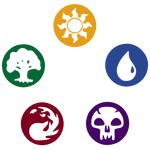Enemy colors are two opposed colors of the color pie (,
), (
,
), (
,
), (
,
), (
,
). A deck may be enemy color (e.g., Phyrexian Poison). A multicolored card may require mana from enemy colors in order to play it (e.g. Angel of Despair).
Enemy colors naturally repel each other, and are often hosers.
Several sets have centered around enemy-colored cards. These include Apocalypse, Eventide, and five of the Guilds of Ravnica
White / Black
Life drain
- Target player loses life and you gain life
Since white is the color of gaining life and black is the color of losing life, life drain is a common mechanic of white-black, particularly among cards of the Orzhov Syndicate. Example cards include Debt to the Deathless and Agent of Masks. This manifests itself in the mechanics lifelink (Divinity of Pride) and extort (Kingpin's Pet), as well a number of white-black effects that hinge on a player's life total.
Exiling
White and black combine to be the colors most able of exiling permanents of any kind. Examples of this include Unmake, Castigate and Identity Crisis. A number of these spells, such as Merciless Eviction, also serve as board wipes.
Multicolored examples
- Death Grasp - combines black X dealing damage spell with white's gain life onto a very efficient sorcery
- Mortify - combines white's disenchantment ability with black's creature destruction onto one card with no drawback (i.e. cannot target black creatures)
Black / Green
Reclamation
Black-green cards have strong interaction with the graveyard, with many effects allowing cards to be returned from the graveyard to your hand (Desecrator Hag) or to the battlefield (Bloodbond March). This is supported by mechanics such as dredge that combine reclamation with "self-mill" effects.
Exiling from the graveyard
A recurring theme among black-green is exiling creature cards from graveyards. These can be either from your own graveyard or from an opponent's. This effect is often accompanied by some positive effect, such as creature tokens (Necrogenesis) or +1/+1 counters (scavenge).
Regeneration
Fitting in with the theme of death and revival is regeneration. Examples in black-green include Odius Trow and Lotleth Troll.
Permanent destruction
Since black is good at destroying creatures and lands, and green at destroying enchantments and artifacts, permanent destruction is a minor theme of black-green. Examples include Putrefy, Maelstrom Pulse, and (as a board wipe) Gaze of Granite. One way that black-green is particularly good at destroying creatures is with the mechanic deathtouch.
Multicolored examples
- Consume Strength - combines green's "pump" effect with black's "weakness" effect onto a very efficient instant
- Putrefy - combines green's dislike of artifacts with black's creature destruction onto one card with no drawback (i.e. cannot target black creatures)
Green / Blue
+1/+1 counters
Green's penchant for creatures combines with blue's "mad scientist" tendencies to creature large creatures (often mutants) that have lots of +1/+1 counters. In Ravnica, this is achieve with both the graft and evolve effects. Examples include Nimbus Swimmer, Lorescale Coatl and Fathom Mage
Card drawing
Blue and green are the two strongest colors in terms of card drawing, and blue-green has both powerful draw spells (Biomantic Mastery) and creatures with repeatable card drawing effects (Cold-Eye Selkie, Fathom Mage).
Multicolored examples
- Winged Coatl - combines the Evergreen mechanics common to green - deathtouch and blue - flash, flying onto one creature efficiently
- Yavimaya's Embrace - combines blue's "stealing" creatures from opponents with green's creature boosting "pump" effect and trample
Red / Blue
Multicolored examples
- Magefire Wings - combines red's power enhancing effect with blue's flying onto one enchantment efficiently
- Schismotivate - combines red's power enhancing effect with blue's power reducing effect onto a very efficient instant
Red / White
Multicolored examples
- Cerodon Yearling - combines the Evergreen mechanics common to red - haste and white - vigilance onto one creature efficiently
- Lightning Helix - combines red's Lightning Bolt with white's life gain of Healing Salve onto one card that does the same as two mentioned
Apocalypse
The Enemy color theme was especially strong in the Apocalypse set. It featured:
- Enemy color painlands
- Enemy color split cards
- Cards with enemy color kicker costs (i.e. Orim's Thunder)
- Cards with two enemy color kicker costs (i.e. Anavolver)
- Cards with abilities requiring an enemy color (i.e. Angelfire Crusader)
- Enchantments which gave bonuses if you controled cards of an enemy color (i.e. Ana Sanctuary)
- Multicolored cards with enemy color casting costs
External references
- Mark Rosewater (February 19, 2002). "Hate Is Enough". magicthegathering.com. Wizards of the Coast.
- Mark Rosewater (February 18, 2002). "Enemy Mine". magicthegathering.com. Wizards of the Coast.

